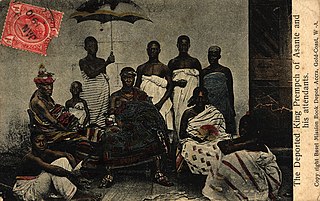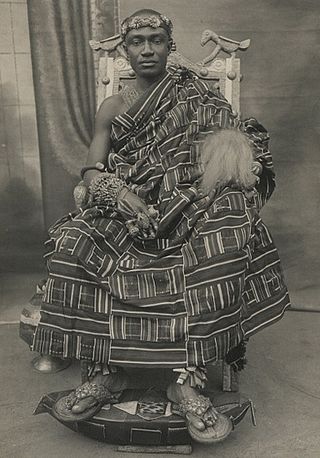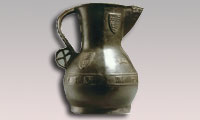
Kumasi, also spelled as Comassie or Coomassie, is a city and the capital of the Kumasi Metropolitan district and the Ashanti Region of Ghana. It is the second largest city in the country, with a population of 443,981 as of the 2021 census. Kumasi is located in a rain forest region near Lake Bosomtwe and is located about 200 kilometres (120 mi) from Accra. Major ethnic groups who lived in Kumasi are the Asante, Mole-Dagbon and Ewe. The current mayor of the metropolitan is Samuel Pyne.
Kwaku Dua Panin was the eighth Asantehene of the Ashanti Empire from 25 August 1834 until his death.

Asante Kotoko Sporting Club, simply known as Asante Kotoko, is a professional football club founded on 31 August 1935 and based in Kumasi in the Ashanti Region of Ghana. Nicknamed the Porcupine Warriors, they compete in the Ghana Premier League and play their home matches at the Baba Yara Stadium in Amakom, Kumasi.

In modern usage, an aquamanile is a ewer or jug-type vessel in the form of one or more animal or human figures. It usually contained water for the washing of hands over a basin, which was part of both upper-class meals and the Christian Eucharist. Historically the term was used for a basin used for priest's ablutions. The water was supplied by a subdeacon, and aquamanile was a symbol of subdeaconate. The term was later transferred onto secular ewers. Most surviving examples are in metal, typically copper alloys, as pottery versions have rarely survived.

The Anglo-Ashanti wars were a series of five conflicts that took place between 1824 and 1900 between the Ashanti Empire—in the Akan interior of the Gold Coast—and the British Empire and its African allies. The wars were mainly due to Ashanti attempts to maintain and enforce their imperial control over the coastal areas of present-day Ghana, where peoples such as the Fante and the Ga had come under the protection of the British. Although the Ashanti emerged victorious in some of these conflicts, the British ultimately prevailed in the fourth and fifth conflicts, resulting in the complete annexation of the Ashanti Empire by 1900.

The War of the Golden Stool, also known as the Yaa Asantewaa War, the Third Ashanti Expedition, the Ashanti Uprising, or variations thereof, was a campaign in 1900 during the series of conflicts between the United Kingdom and the Ashanti Empire, an autonomous state in West Africa that fractiously co-existed with the British and its vassal coastal tribes.

The Asante Empire, also known as the Ashanti Empire, was an Akan state that lasted from 1701 to 1901, in what is now modern-day Ghana. It expanded from the Ashanti Region to include most of Ghana and also parts of Ivory Coast and Togo. Due to the empire's military prowess, wealth, architecture, sophisticated hierarchy and culture, the Asante Empire has been extensively studied and has more historic records written by European, primarily British, authors than any other indigenous culture of sub-Saharan Africa.

Prempeh I was the thirteenth king ruler of the Ashanti Empire and the Oyoko Abohyen Dynasty. King Prempeh I ruled from March 26, 1888 until his death in 1931, and fought an Ashanti war against Britain in 1895-6.

The Manhyia Palace is the seat of the Asantehene, as well as his official residence. It is located in Menshyia, Kumasi, the capital of the Ashanti Region of Ghana. The first palace is now a museum. Otumfuor Opoku Ware II built the new palace, which is close to the old one and is where the current Asantehene, Otumfuor Osei Tutu II, resides.
Juaben is a small town in the Ejisu-Juaben Municipal District, a district in the Ashanti Region of Ghana.

Bonwire is a town in Ghana, located in the Ejisu-Juaben Municipal district within the Ashanti Region. The town is located about 18 km on the Kumasi-Mampong road. According to Akan oral tradition, Kente originates from Bonwire.

Sir Frederick Mitchell Hodgson, was a British colonial administrator who was Governor of the Gold Coast (1898–1900), Barbados (1900–04) and British Guiana (1904–11).

Prempeh II, was the 14th Asantehene, or king of the Ashanti, reigning from 22 June 1931 to 27 May 1970.

The Wenlok jug or Wenlock jug is a rare surviving example of an English bronze jug from the 15th century, with great significance for the study of bronze working in medieval England. Only two similar jugs are known in the UK. The Wenlok jug is the smallest of the three, but bears the earliest maker's mark for the English founder - possibly a bell founder - who cast it. The other examples are the Asante Ewer, which retains its lid and is held by the British Museum having been found at Kumasi in the Gold Coast in 1896 during the Anglo-Ashanti wars, and the Robinson jug, which was found in a farmhouse in Norfolk in the 1879 and is now in the collection of the Victoria & Albert Museum. All bear inscriptions in English and were made from leaded bronze, an alloy of copper, tin and lead, cast in a two-part mould in a similar manner using bronze spacers to separate the inner and outer moulds, with similar decorative motifs.
Major-General Sir Francis Cunningham Scott, was a British Army officer who commanded in the Fourth Anglo-Ashanti War in 1895–1896.
Kofi Koduah Sarpong is a Ghanaian business executive and consultant. He is a member of the New Patriotic Party of Ghana. He served as Executive Chairman of Ghanaian football club, Kumasi Asante Kotoko from 2010 to 2013.

The history of Kumasi dates to the late 17th century when it emerged as the capital of the Ashanti Empire. Although various oral sources differ on the origin of Kumasi, majority agree it emerged as the capital of Ashanti under Osei Kofi Tutu I in the late 17th century. In the early 18th century, Kumasi was invaded and sacked by the Aowin but the invasion was curbed by Asantehene Opoku Ware I. 19th century written accounts by European visitors described the neatness and sophistication of the city. The population of Kumasi under the Ashanti Empire varies per source. The city was ransacked by the British Empire in 1874 during the Anglo-Ashanti Wars. A Civil war occurred within the 1880s which led to further decline of Kumasi. Another British invasion of the city occurred within 1895—1896 as Kumasi was left in ruins.

Friedrich Augustus Louis Ramseyer also Fritz Ramseyer was a Swiss-born Basel missionary, who was captured by the Asante in 1869 in colonial Ghana, together with his wife Rosa Louise Ramseyer, Basel mission technical staff, Johannes Kühne and French trader, Marie-Joseph Bonnat. Ramseyer was later released in 1874 and pioneered the Christian mission in Kumasi and the rest of Asante. Additionally, he spearheaded the planting of churches in Abetifi. Apart from his evangelism, Ramseyer was instrumental in the expansion of opportunities in the fields of education, artisan industry training, land acquisition for building design and manpower development in the areas he lived and worked in.

Ghana–United Kingdom relations are the diplomatic, historical and trade relations between Ghana and the United Kingdom. Modern state Ghana-UK relations began when Ghana became independent from the UK in 1957 as the Dominion of Ghana.

The Aban was a stone structure that served as a palace for the Asantehene and played the other function of displaying his craft collection. It was constructed in 1822 as a project of Asantehene Osei Bonsu, with the stones and labor provided by the Dutch at Elmina. The palace was destroyed in 1874 during the British invasion and its remains were used to construct a British fort in the late 19th century.
















